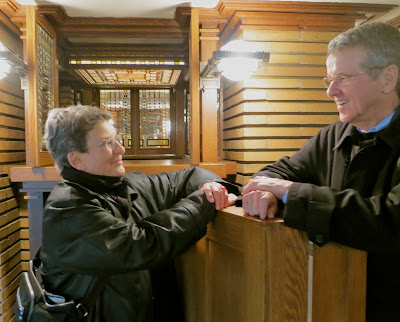 |
| Phyllis Lambert and Jack Quinan (Photograph by Mary Roberts, CEO of the MHRC) |
You could argue that without Phyllis Lambert there wouldn't be a Martin House, or at least the house as it stands today, nearly completely rebuilt and restored. In the early 1980s when the Wright-Martin Papers were about to be auctioned in Los Angeles there was a mad rush here in Buffalo to raise funds to purchase the papers (which proved vital to the whole restoration process). We put together $50,000 from various foundations only to discover that we would be competing against Phyllis Lambert and her Canadian Centre for Architecture, a newly formed architectural archive and museum that is now one of the leading institutions of its kind in the world. Ms. Lambert kindly agreed not to enter the bidding until after our $50,000 limit was exceeded. As it happened, her representative was ultimately outbid by a Chicago dealer who then attempted to sell the papers to the CCA. Sensitive to the notion that the Wright-Martin Papers really should be in Buffalo with the Martin House, Ms. Lambert flew this writer to Montreal to advise during the negotiation. She decided against the purchase, and soon thereafter it became apparent that Paul Hanna, a Wright client at Stanford University had $50,000 and was also interested in the papers. We (Hanna and UB) decided to pool our resources, bought the papers for $100,000, and divided them between the University of Buffalo (those from 1902 to 1916) and Stanford (those from 1917 to 1945).
So it was a special pleasure to show Phyllis Lambert the Martin House after all these years.
I must admit that I was somewhat trepidatious given Ms. Lambert's passion for the work of Mies van der Rohe, beautifully articulated in her new book, Building Seagram, but she was delighted with the house and the restoration and particularly attentive to details reminiscent of the work of the great Italian interpreter of Wright, Carlo Scarpa, the subject of a major exhibition at the CCA a few years ago. This comes as no surprise as Phyllis Lambert, through the auspices of the Canadian Center for Architecture and the numerous buildings she has commissioned and restored across North America, in Cairo (the Ben Ezra Synagogue, with foundations dating back to the 11th century), Moscow (the Konstantin Melnikov House), and elsewhere, has defined the very idea of architectural patronage for the twentieth and twenty-first centuries.
 |
| Philip Johnson, Mies van der Rohe, and Phyllis Lambert (New York Times) |
 |
| Frank Lloyd Wright, an interpreter, and Mies van der Rohe at the Johnson's Wax Building site in 1937 |
No comments:
Post a Comment